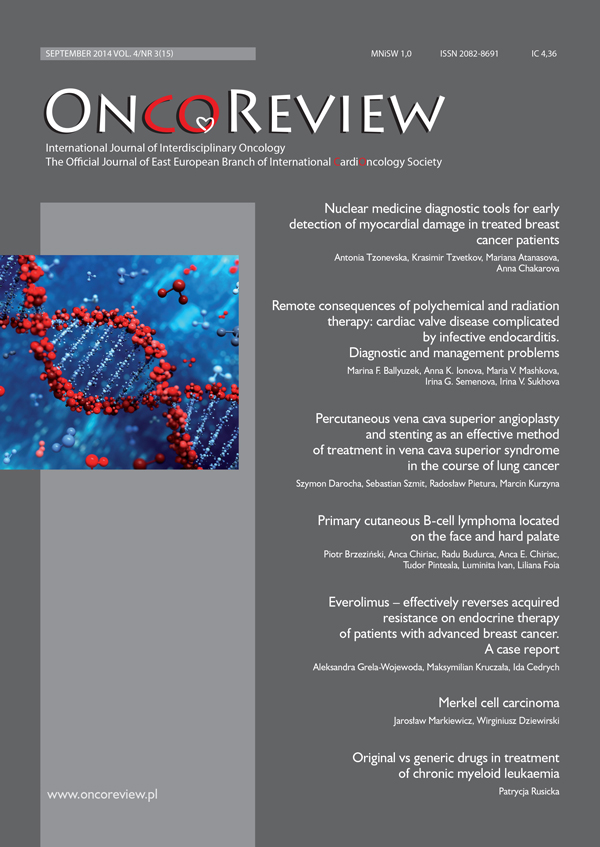Nuclear medicine diagnostic tools for early detection of myocardial damage in treated breast cancer patients Original article
Main Article Content
Abstract
The most severe side effect in treated patients with breast cancer is treatment-induced cardiotoxicity, leading to chronic heart failure or CAD, and worsening the patient’s quality of life. The early detection and medical protection is needed to prevent it.
The aim of the study was to detect early signs of cardiotoxicity.
Material and methods: 148 breast cancer patients were included in the study: 64 after combined treatment (chemo- and radiotherapy), 56 patients after radiotherapy, 28 patients after chemotherapy. We performed myocardial scintigraphy (GSPECT-CT), EchoCG, proBNP measurement.
Results: The analysis of the results present early signs of cardiotoxicity in 46% of investigated patients. Exclusion criteria were: patients with cardiac symptoms, pathologic ECG and LVEF. EchoCG results indicated normal systolic function in all (n = 120) patients (mean LVEF 64%), in 79 (66%) patients – normal diastolic function, in 41 (34%) patients diastolic dysfunction was found. Myocardial scintigraphy: normal systolic function was found in all patients (mean LVEF 68%), no segmental dysfunction, diastolic dysfunction had 47 (32%) patients. Hypoperfused myocardial segments were found in 39 (26%) patients. Normal myocardial perfusion had 125 (84%) patients. ProBNP: normal proBNP values were measured in 64 patients, increased values – in 7 (9%) patients.
Conclusion: The results indicated earlier detection of signs of cardiotoxicity in comparison to the routine diagnostic methods. Applying myocardial GSPECT-CT, we can detect early signs of myocardial damage before positive results from routine tests for cardiotoxicity and before severe morphologic myocardial damage.
Downloads
Article Details

This work is licensed under a Creative Commons Attribution-NonCommercial 4.0 International License.
Copyright: © Medical Education sp. z o.o. This is an Open Access article distributed under the terms of the Attribution-NonCommercial 4.0 International (CC BY-NC 4.0). License (https://creativecommons.org/licenses/by-nc/4.0/), allowing third parties to copy and redistribute the material in any medium or format and to remix, transform, and build upon the material, provided the original work is properly cited and states its license.
Address reprint requests to: Medical Education, Marcin Kuźma (marcin.kuzma@mededu.pl)
References
2. Pai VB, Nahata MC. Cardiotoxicity of chemotherapeutic agents: incidence, treatment and prevention. Drug saf 2000; 22: 263-302.
3. Shan K, Lincoff M, Young JB. Anthracycline-Induced Cardiotoxicity. Anals of internal medicine 1996; 125: 147-158.
4. Butany J, Ahn E, Luk A. Drug-related cardiac pathology. J Clin Pathol 2009; 62: 1074-1084.
5. Pfeffer B, Tziros C, Katz RJ. Current Concepts of Anthracycline Cardiotoxicity: Pathogenesis, Diagnosis and Prevention. Br J Cardiol 2009; 16(2): 85-89.
6. Bonadonna G, Zambetti M, Valagussa P. Sequential or alternating doxorubicin and CMF regimens in breast cancer with more than three positive nodes. Ten-year results. JAMA 1996; 273: 542-547.
7. Berry G, Billingham M, Alderman E et al. The use of cardiac biopsy to demonstrate reduced cardiotoxicity in AIDS Kaposi’s sarcoma patients treated with pegylated liposomal doxorubicin. Annals of Oncology 1998; 7(9): 711-716.
8. Fisher B, Redmond C, Wickerham DL et al. Doxorubicin-containing regimens for the treatment of stage II breast cancer: The National Surgical Adjuvant Breast and Bowel Project experience. J Clin Oncol 1989; 7: 572-82.
9. Haq MM, Legha SS, Choksi J et al. Doxorubicin-induced congestive heart failure in adults. Cancer 1985; 56: 1361-5.
10. Olson RD, Mushlin PS. Doxorubicin cardiotoxicity: analysis of prevailing hypotheses. FASEB J 1990; 4(13): 3076-86.
11. Lipshultz SE, Sanders SP, Colan SD et al. Monitoring for anthracycline cardiotoxicity. Pediatrics 1994, 93(3): 433-437.
12. Steinherz LJ, Steinherz PG, Tan CT et al. Cardiac toxicity 4 to 20 years after completing anthracycline therapy. JAMA 1991; 266: 1672-7.
13. Combs A, Acosta D. Toxic mechanisms of the heart: a review. Toxicol Pathol 1990; 18(4): 583-596.
14. Carrio IM, Ertorch A, Lopez-Pousa A. Assessing anthracycline cardiotoxicity in the 1990s. Eur J Nucl Med 1996; (23)4: 359-364.
15. Larsen RL, Jakacki RI, Vetter VL et al. Electrocardiographic changes and arrhythmias after cancer therapy in children and young adults. Am J Cardiol 1992; 70: 73-7.
16. Tjeerdsma G, Meinardi M, Van der Graaf WTA et al. Early detection of anthracycline induced cardiotoxicity in asymptomatic patients with normal left ventricular systolic function: autonomic versus echocardiographic variables. Heart 1999; 81: 419-42.
17. Stoddard MF, Seeger J, Liddell NE et al. Prolongation of isovolumetric relaxation time as assessed by Doppler echocardiography predicts doxorubicin-induced systolic dysfunction in humans. J Am Coll Cardiol 1992; 20: 62-69.
18. Sharma R, Sharma K, Vibhuti D. et al. Cardiac risk stratification: role of the coronary calcium score. Vasc Health Risk Manage 2010; 6: 603-611.
19. Tham YL, Verani MS, Chang J. Reversible and irreversible cardiac dysfunction associated with trastuzumab in breast cancer. Breast Cancer Res Treat 2002; 74(2): 131-134.
20. Emily Ho E, Brown A, Barrett P et al. Subclinical anthracycline- and trastuzumab-induced cardiotoxicity in the long-term follow-up of asymptomatic breast cancer survivors: a speckle tracking echocardiographic study. Heart 2010; 96: 701-707.
21. Tomiak E, Piccart M, Mignolet F et al. Characterisation of complete responders to combination chemotherapy for advanced breast cancer: a retrospective EORTC breast group study. Eur J Cancer 1996; 32A: 1876-1887.
22. Olmas R, Hoefnagel C et al. Usefulness of 111In-antimyosin in mapping anthracycline myocardial injury. Update 1995; 2(2): 44-45.
23. Valdés Olmos RA, ten Bokkel Huinink WW, ten Hoeve RF et al. Assessment of anthracycline related myocardial adrenergic derangement by 123 I- MIBG. Eur J Cancer 1995; 31A(1): 26-31.
24. Miyagawa M, Tanada S, Hamamoto K. Scintigraphic evaluation of myocardial uptake of 201 thallium and technetium 99m pyrophosphate utilizing a rat model of chronic doxorubicin cardiotoxicity. Eur J Nucl Med 1991; 18: 332-338.
25. Piwnica-Warms D, Chiu M, Kronauge J. Detection of adriamycin cardiotoxicity in cultured chick heart cells with 99mTcMIBI. Cancer chemother Pharmacol 1993; 32(2): 386-391.

